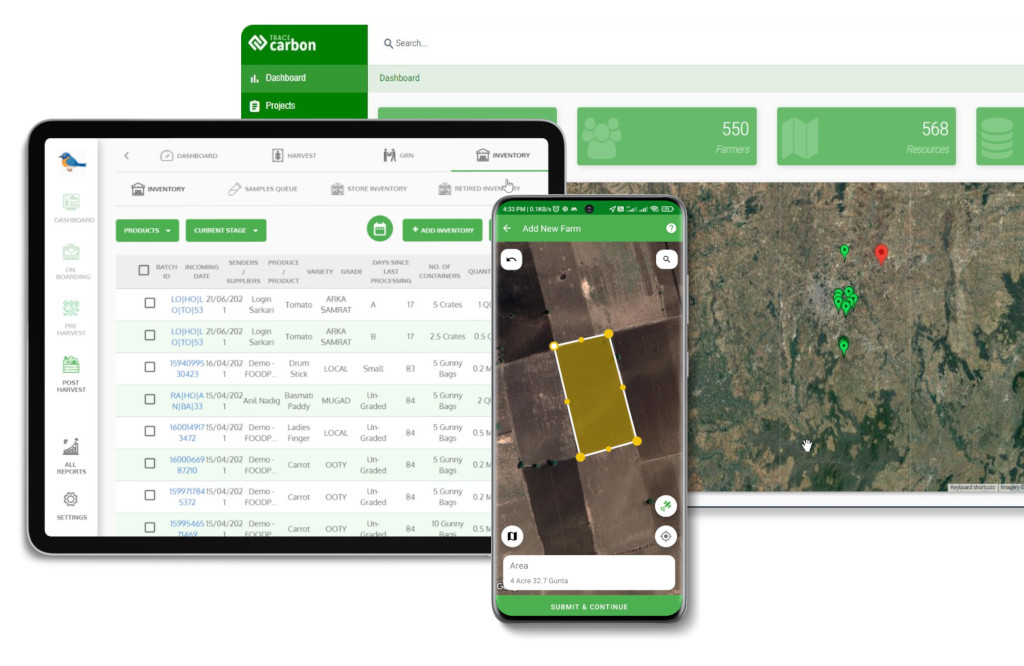Contact: +91 99725 24322 |
Menu
Menu
Quick summary: Discover how traceability for ESG compliance helps agri-food businesses meet EUDR, CSRD, and sustainability goals. Learn key features to look for — and how to turn data into proof.

Sustainability reporting is no longer a feel-good initiative — it’s a boardroom mandate. From EUDR to CSRD and Scope 3 emissions, regulatory and investor pressure is mounting. But here’s the hard truth: you can’t manage what you can’t trace — and you definitely can’t report what you can’t verify. That’s why traceability for ESG compliance has moved from a ‘nice to have’ to a strategic necessity.
For ESG officers, procurement heads, and compliance teams in agri and food supply chains, the biggest challenge isn’t intention — it’s visibility. Can you prove where your raw materials came from? Who produced them? Whether they were grown sustainably, on legal land, without deforestation or forced labor? If the answer is “not yet,” you’re not alone — but you are at risk.
Key Takeaways
If you’re an ESG officer, you know your job doesn’t stop at writing sustainability reports or ticking off compliance boxes. You’re responsible for proving what your brand claims — with data that’s credible, current, and audit-ready.
That’s where traceability becomes your most powerful tool. But not all traceability platforms are built the same. So, before you invest in one, here are the 5 must-have features that can make or break your ESG success:
If you’re leading ESG in an agribusiness or food supply chain company, chances are you’re being asked a tough question more and more often:
“Can you prove exactly where this product was grown — and whether it came from deforestation-free land?”
That’s where plot-level GPS mapping becomes non-negotiable.
ESG reporting is shifting fast — from vague commitments to data-backed accountability. It’s no longer enough to say your supply is sustainable. You have to show it, ideally down to the coordinates of the farm.
Farm-level visibility allows you to:
It’s more than just dropping a pin on a map.
You need:
This level of granularity ensures that every sustainability claim you make — about legality, forest conservation, or regenerative practices — is grounded in verifiable, geolocated truth.
Let’s say you’re a cocoa exporter sourcing from West Africa. You’re submitting your EUDR Due Diligence Statement. Your buyer asks:
“Can you show us that these 10 containers of cocoa didn’t come from recently deforested land?”
If you’ve mapped each supplier plot with polygons, you can overlay those coordinates on satellite data, demonstrate no land-use change post-2020, and attach the maps to your DDS. That’s not just compliance — that’s ESG credibility.
Take Your Farm Operations Beyond Connectivity Limits
Ready to manage compliance, map farms, and sync critical data — even in the most remote corners of your supply chain? Discover how TraceX’s offline-first platform makes it effortless.
Read the case study and see how digital traceability works — no signal required.
ESG officers want to:
But the biggest fear?
Submitting claims they can’t actually prove.
By investing in plot-level GPS mapping, they turn visibility into accountability — and build ESG programs that hold up under scrutiny.
When you’re building an ESG or sustainability report, the data you need is rarely in one place. Some of it’s in spreadsheets, some buried in emails, and some… is still scribbled on paper at a cooperative office.
And yet, your entire ESG narrative hinges on knowing your producers — not just what they grow, but how, where, and under what conditions. That’s why digital farmer profiles and declarations are one of the most powerful tools ESG officers can use to turn fragmented records into clear, credible impact.
It’s not just a digital contact list. A well-built farmer profile captures:
All of this is digitally stored, timestamped, and tied to traceable batches — meaning you have a complete view of every grower, from compliance to carbon impact.

If you’re reporting on:
…then every one of those claims starts with verified farmer-level data.
And when an auditor asks you to prove it? You don’t scramble. You pull up the profile — digitally, instantly.
Instead of re-collecting the same information for every audit or report, a digital profile allows you to reuse verified data across multiple frameworks. For example:
It’s all there. One profile, multiple compliance wins.
Here’s a powerful shift: these profiles don’t just help you meet compliance. They help farmers become more visible, trusted, and investable.
When you digitally document and acknowledge a smallholder’s sustainability practices, you’re:
That’s not just traceability. That’s inclusion.
If you’re leading ESG or sustainability in a food or agri supply chain, you already know the big question buyers, investors, and regulators are asking:
“Can you show me exactly where this product came from — and what happened to it along the way?”
Without batch-level traceability, your answer is usually: kind of. You might know which region or supplier it came from, but you can’t always link it to a specific farm, batch, or container — and that’s where even well-intentioned ESG claims start to fall apart.
ESG is no longer just about inputs and outputs. It’s about every step in between. To back your claims on carbon, water, human rights, or deforestation, you need to track:
This full chain of custody ensures that when you make a claim like:
“This cocoa is deforestation-free and Rainforest Alliance certified”
…it’s not just a sticker. It’s digitally provable.
Want to ensure full traceability from farm to buyer — with batch IDs that reflect your exact workflows? See how TraceX helps you streamline operations, strengthen compliance, and build trust with custom batch ID tracking.
Read the case study and take control of your crop traceability, one batch at a time.
Let’s say your team is reporting on:
In every one of those examples, the accuracy and integrity of the claim hinges on your ability to trace the batch — not just the farm or region.
If you’re mixing compliant and non-compliant inputs along the way? Your ESG story falls flat.
This is what audit-ready traceability looks like — and it’s the foundation for data-backed ESG disclosures.
No ESG officer wants to get caught off guard during an audit, investor meeting, or regulatory filing. Yet with hundreds (or even thousands) of smallholders, suppliers, and sourcing regions in your value chain, it’s impossible to track everything manually.
That’s where risk scoring and alert dashboards come in — not just as compliance tools, but as early warning systems for your sustainability and sourcing teams.

You’re expected to disclose and manage risks around:
But what if you could see those risks as they emerge — not after the damage is done?
Risk dashboards make that possible by:
Under frameworks like the Corporate Sustainability Reporting Directive (CSRD), you’re expected to show how you identify, assess, and mitigate risks that are financially and environmentally material.
A good traceability platform should help you:
Because the best ESG strategies aren’t just ethical. They’re intelligent, informed — and always one step ahead.
For most ESG officers, reporting is the bottleneck. You’ve done the work, gathered the data, maybe even led field assessments. But when it comes to actually submitting your ESG disclosures or EUDR Due Diligence Statements (DDS), you’re buried under a pile of Excel sheets, PDFs, missing files, and last-minute formatting requests from other departments.
And the worst part? You’re not even sure the final report captures the full story.
That’s why integrated export tools and auto-generated reporting aren’t just “nice to have” — they’re what keep your ESG engine running smoothly, confidently, and credibly.

In a world of growing regulation and rising ESG scrutiny, the winners won’t be those with the flashiest goals — but those with the cleanest, most defensible data. And that starts with a traceability platform that does the heavy lifting for you — not just in the field, but in the report.
For most ESG and sustainability leaders, traceability software is still seen as an operational tool — a way to log farm data, manage audits, or tick off compliance requirements. But here’s the truth: the platform you choose today will define how trustworthy and scalable your ESG program is tomorrow.
This isn’t just a tech decision — it’s a strategic call that impacts your brand credibility, investor confidence, and long-term regulatory readiness.
When you’re deep in the weeds of EUDR, CSRD, or your company’s net-zero roadmap, you don’t just need a traceability tool. You need the right one — built for your teams, your suppliers, and your future ESG needs.
Here’s what to look for:
And that’s exactly why choosing a field-tested, compliance-ready platform like TraceX isn’t just about software — it’s about future-proofing your sustainability strategy.
TraceX’s end-to-end digital platform designed to help agri-food businesses measure, manage, and monitor sustainability right from the farm level — all the way to the final product.
It enables real-time traceability and ESG compliance by capturing critical data on:
In today’s compliance-driven, climate-conscious world, ESG reporting is no longer optional — and neither is traceability. But it’s not just about collecting data; it’s about using that data to build transparency, trust, and transformation. Whether you’re preparing for EUDR audits, CSRD disclosures, or stakeholder ESG demands, the right traceability platform gives you the evidence, efficiency, and edge you need.
Because at the end of the day, ESG isn’t about what you promise — it’s about what you can prove.
Yes — traceability connects sustainability claims with verifiable data. Without it, ESG reports risk becoming generic or non-compliant, especially under frameworks like EUDR or CSRD.
A robust platform captures reusable data — such as land use, GPS coordinates, certifications, and risk flags — that can power disclosures across RA, Organic, FairTrade, EUDR, and carbon initiatives.
Absolutely. Platforms like TraceX are built for offline-first, multilingual, and scalable use — making traceability work in even the most rural, low-connectivity areas.
